Egiptian Pharaoh Maatkare Hatshepsut
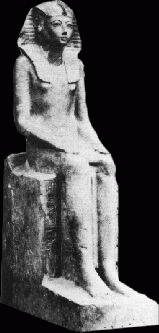
The Queen Who Would Be King – 1473-1458 B.C.
Hatshepsut was an 18th-dynasty pharaoh who was one of the handful of female rulers in Ancient Egypt. Her reign was the longest of all the female pharaohs. Her funerary temple still stands as a tribute to her incredible rise to power.
Hatshepsut was the daughter of the Pharaoh Tuthmosis I and Queen Ahmose, both of royal lineage.
Hatshepsut was married to her own half-brother, Tuthmosis II, with whom she reigned for some 14 years. Realizing his sister-wife’s ambitious nature, Tuthmosis II declared his son by the harem girl Isis to be his heir, but when the young Tuthmosis III came to the throne, Hatshepsut became regent and promptly usurped his position as ruler.
To support her cause she claimed the God Amon-Ra spoke, saying “Welcome my sweet daughter, my favorite, the king of Upper and Lower Egypt, Maatkare,Hatshepsut. Thou art the King, taking possession of the Two Lands.”
She dressed as a king, even wearing a false beard and the Egyptian people seem to have accepted this unprecedented behavior.
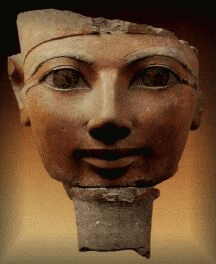
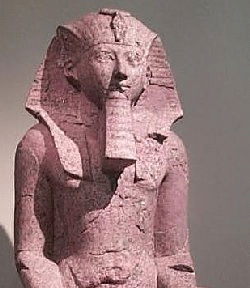
Hatshepsut had herself portrayed in the royal headdress, sometimes as a woman with prominent breasts but more often as male in body as well as costume. Her self-promotion, which extended to a miraculous conception and fictitious coronation in childhood, involved deliberately obscuring the rightful ruler, Tuthmosis III, who was a man by the time he succeeded to unfettered rulership in 1483 BC.
Hatshepsut accomplished what no woman had before her. She ruled the most powerful, advanced civilization in the world. Her consort and true love was her advisor, Senmut.
She remained in power for twenty years during which time the Egyptian economy flourished. She expanded trade relations.
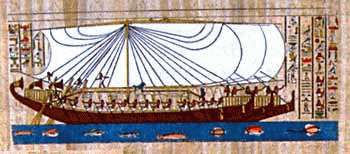
The Egyptians sent trading missions to Punt, a region of East Africa that was rich in gold, resins, ebony, blackwood, ivory and wild animals, including monkeys and baboons. They also went in search of slaves. The best-documented mission was sent during the reign of Hatshepsut. Scenes from these expeditions are illustrated on her funerary temple at Deir el-Bahari, near the Valley of the Kings.
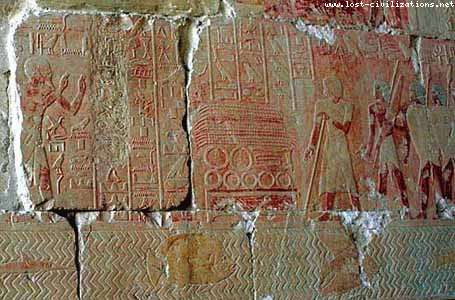
She built magnificent temples as well as restoring many of the old ones, most notably the great mortuary temple at Deir al-Bahari.
The Red Chapel was built between 1498 and 1483 BC.
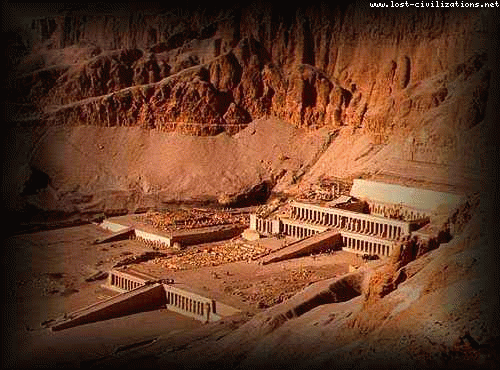
Hidden for more than three millennia, it was
found in 1999 on the banks of the Nile River.
The mortuary temple of Queen Hatshepsut is one of the most dramatically situated in the world. The queen’s architect, Senmut, designed it and set it at the head of a valley overshadowed by the Peak of the Thebes, the “Lover of Silence,” where lived the goddess who presided over the necropolis. A tree lined avenue of sphinxes led up to the temple, and ramps led from terrace to terrace. The porticoes on the lowest terrace are out of proportion and coloring with the rest of the building. They were restored in 1906 to protect the celebrated reliefs depicting the transport of obelisks by barge to Karnak and the miraculous birth of Queen Hatshepsut. Reliefs on the south side of the middle terrace show the queen’s expedition by way of the Red Sea to Punt, the land of incense. Along the front of the upper terrace, a line of large, gently smiling Osirid statues of the queen looked out over the valley. In the shade of the colonnade behind, brightly painted reliefs decorated the walls.
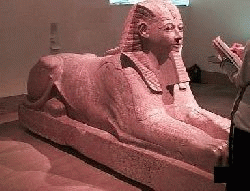
Throughout the temple, statues and sphinxes of the queen proliferate.
Hatshepsut disappeared in 1458 B.C. when Thutmose III, wishing to reclaim the throne, led a revolt. Thutmose had her shrines, statues and reliefs mutilated.